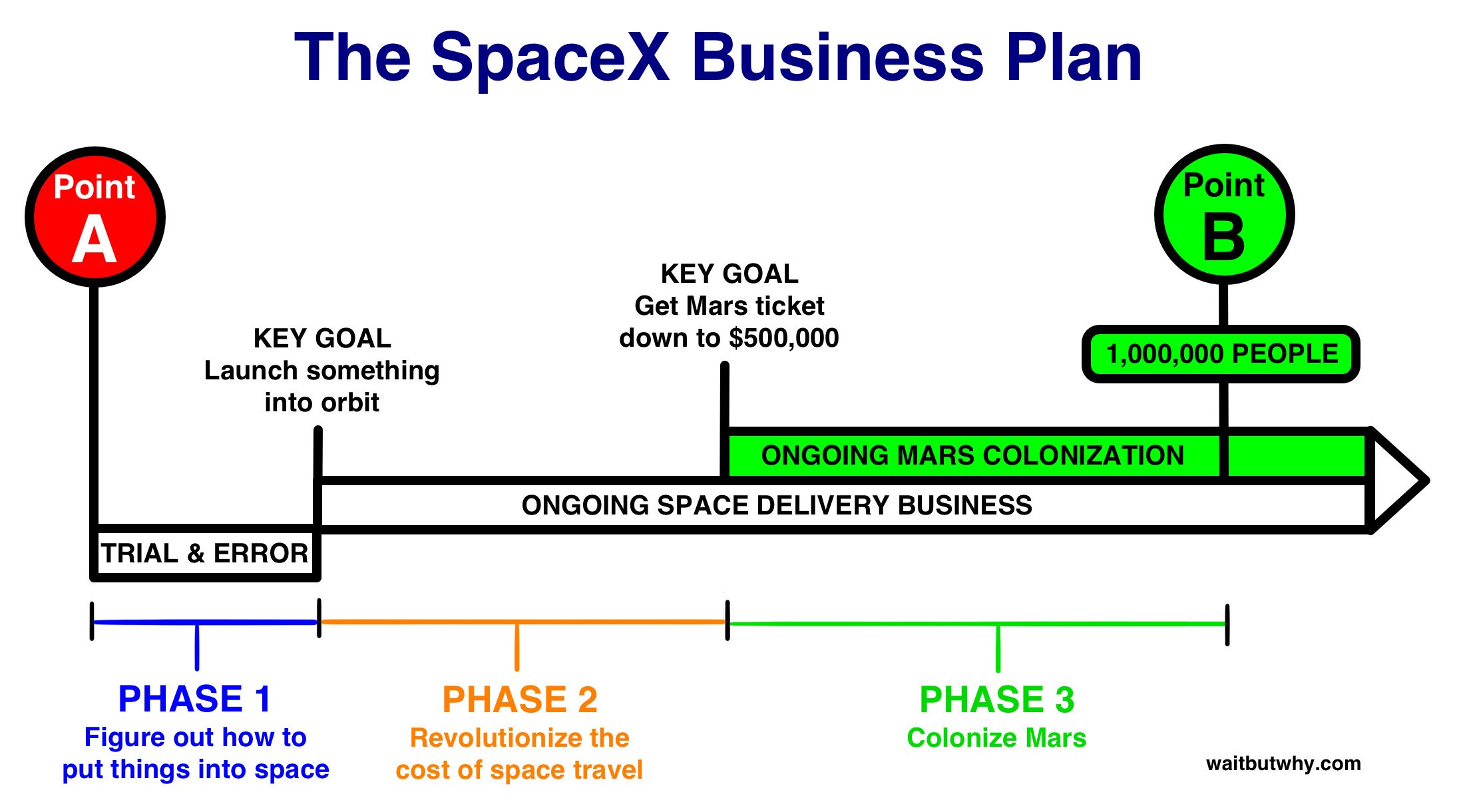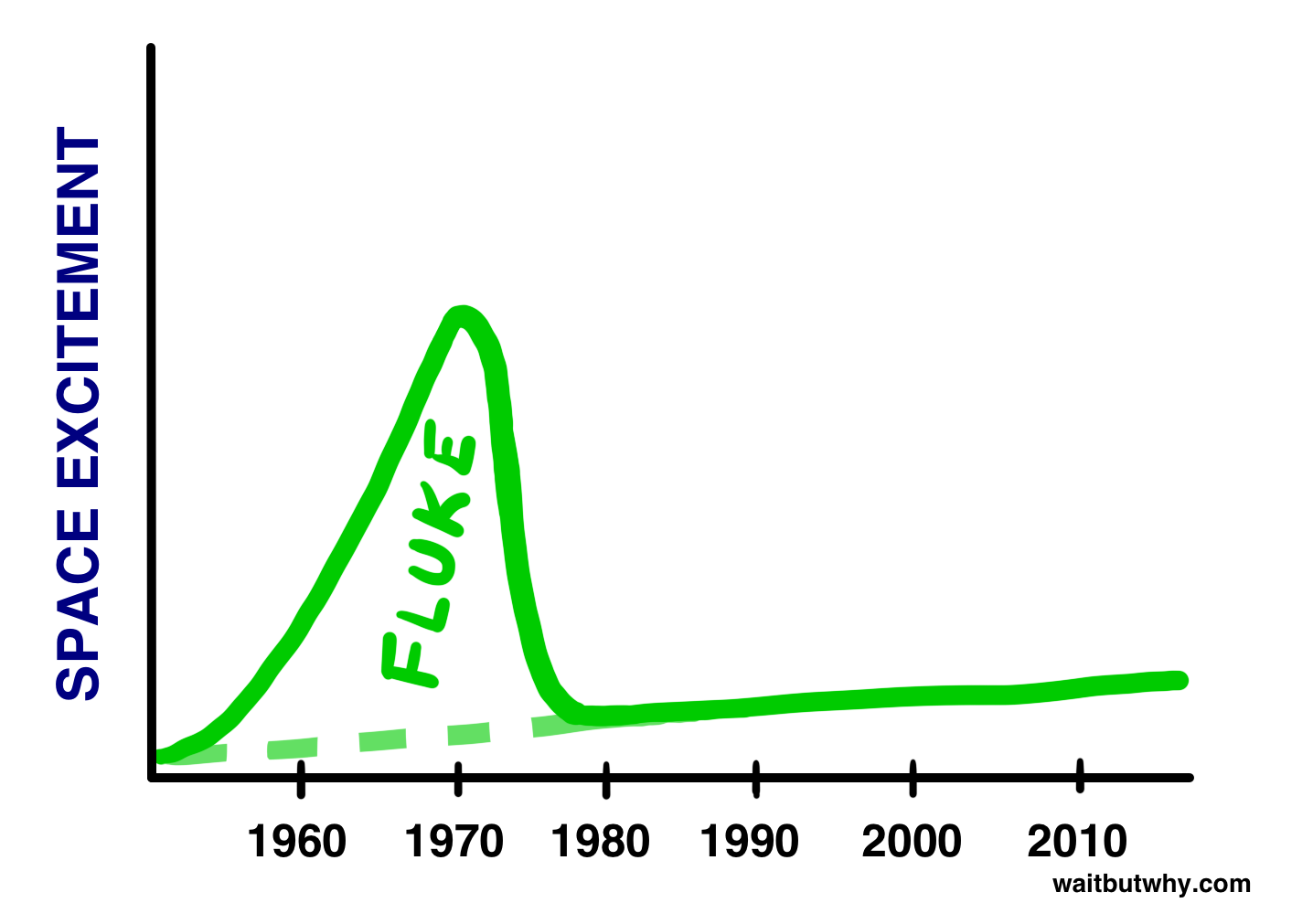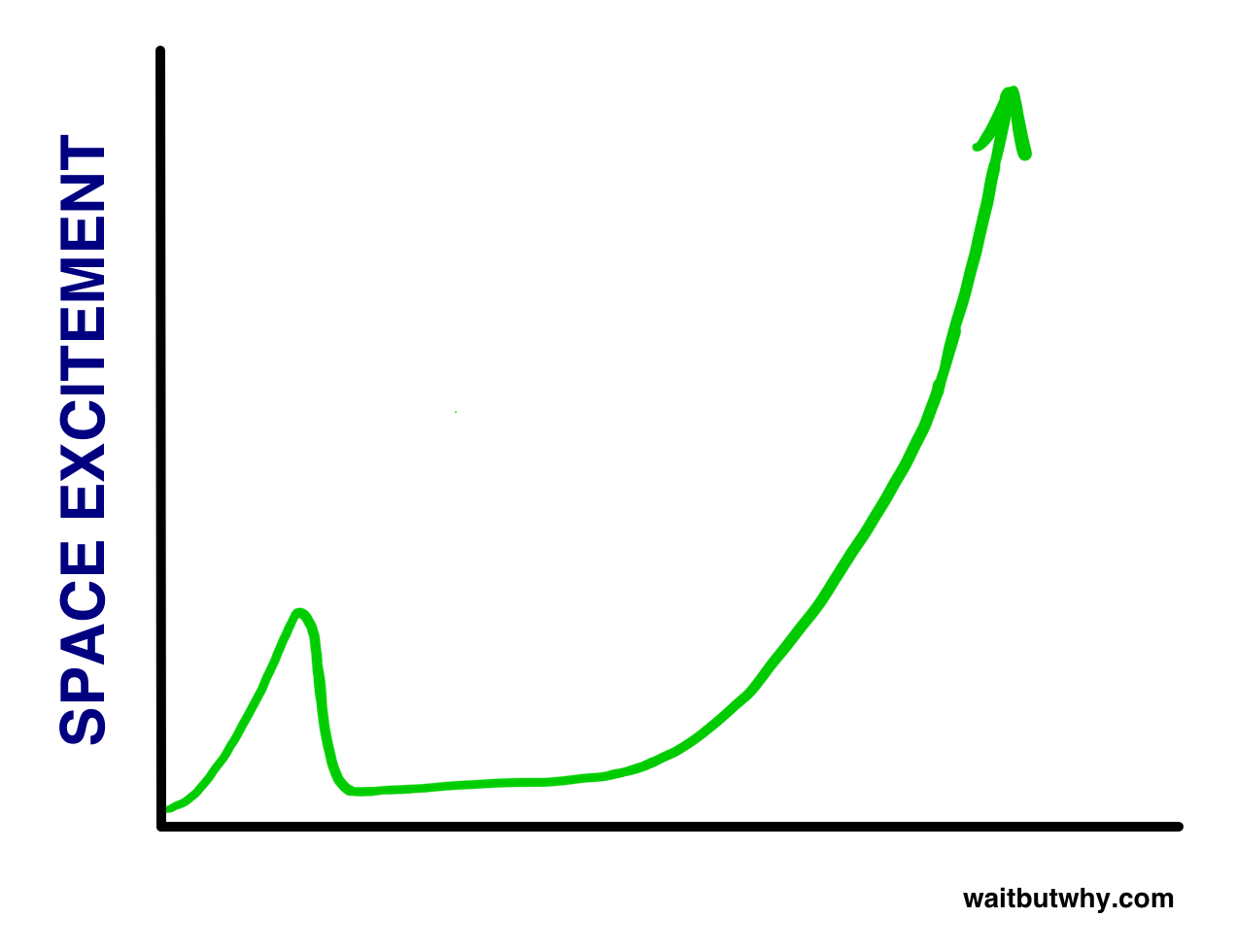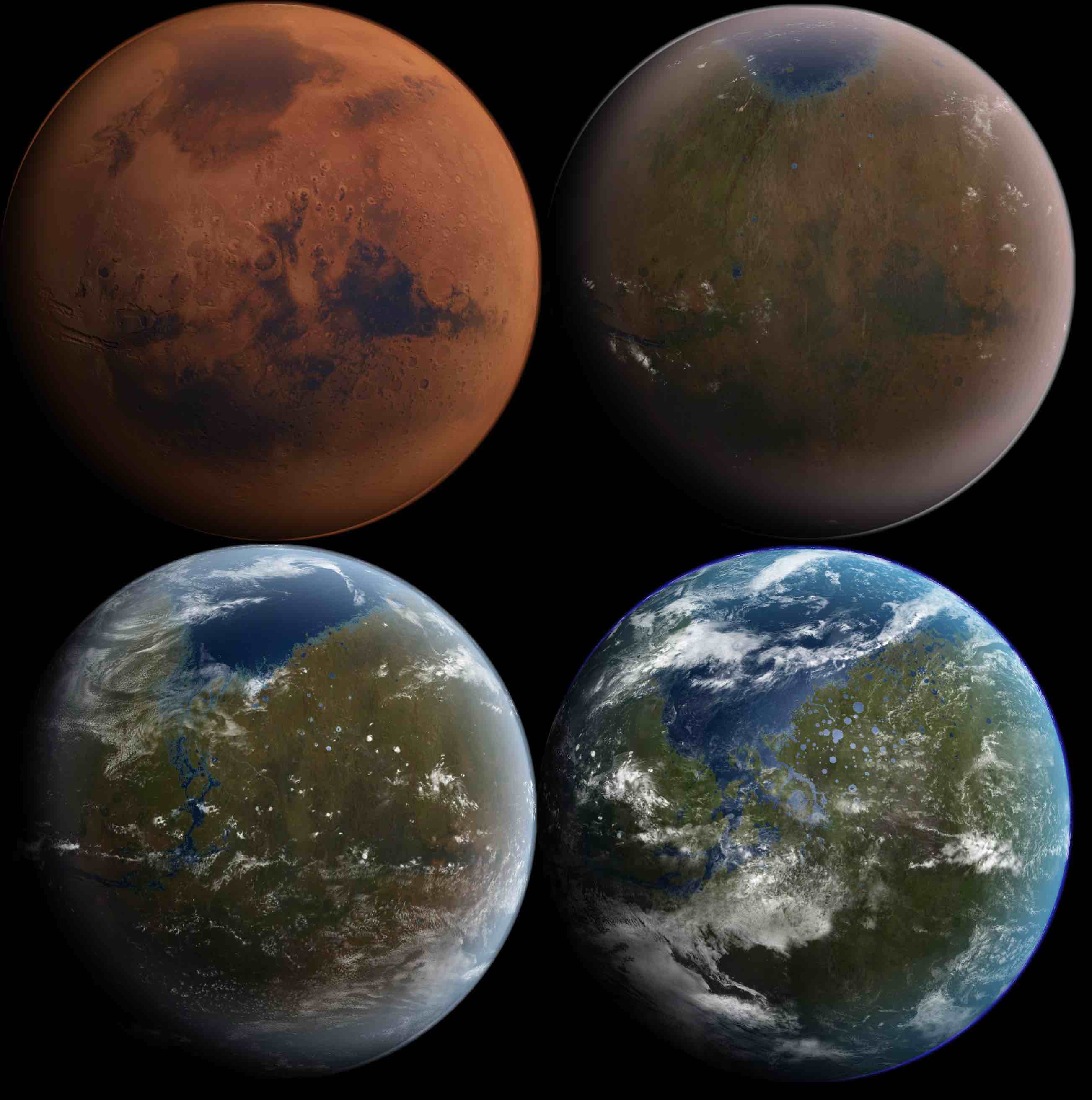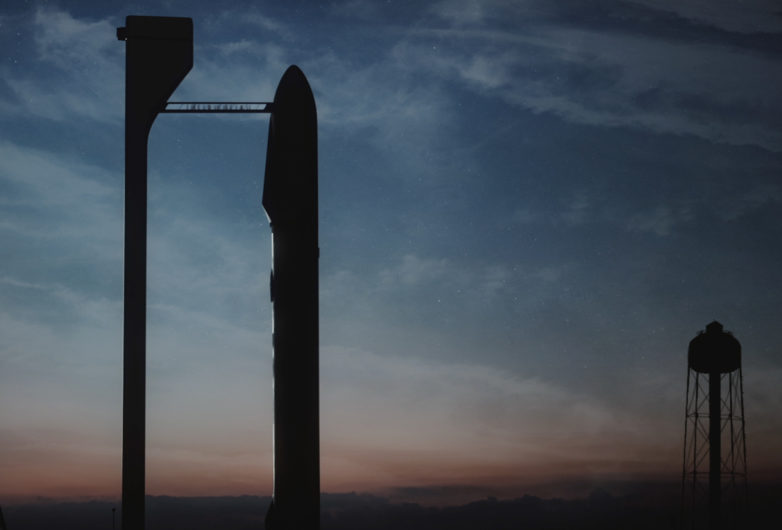Main Character: The Mars Colonial Transporter
Goal: Put 1,000,000 people on Mars
Today, no one is talking about Mars, and very few people think of Mars as a relevant part of the near future. But unless I’ve missed something big or something unexpected happens, in about 10–20 years, people will start going to Mars. You could go to Mars in your lifetime. Crazy things are on the horizon.
This is one of those topics that’s tough to absorb, because as you think about it, your mind will keep drifting back to, “Nahhhh.” Learning about what SpaceX is doing and why they’re doing it can take you from a place where thinking the prospect of humans moving to Mars is totally ludicrous to a place where you accept the logic that it’s actually an important thing to do and something that’s possible and even likely to happen. But that’s different than really believing it’ll happen. As you read this post, even if you agree with what you’re reading, if you had to quickly bet $1,000 on whether people will be moving to Mars in 20 years, there’s a good chance you’d bet against it, because deep down, your brain hasn’t really accepted it. And that’s fair—your brain bases things on experience, and experience tells it that moving to Mars is not something that people ever do.
But I’m pretty sure your brain’s in for some big surprises over the next few decades, for a bunch of reasons, and if you’re willing to accept that possibility, try to absorb the fact that a section titled “Phase 3: Colonize Mars” might actually—really—be based in reality.
Everything from here on is based on the guesswork of Musk and others in the field. Here’s those people’s best crack at predicting how this will all play out:
Before anything with people starts, there will be a preliminary phase where SpaceX sends spacecraft to Mars without any people. The first step, Musk told me, would be to “send an automated spaceship to Mars just to make sure you can send something there and back”—this should happen before 2020. Then, there would be a handful of unmanned cargo missions to bring equipment, habitats, and supplies, so that when the first people start arriving, they’ll be able to not die—they’ll need access to water, a place to live, the tools to convert compounds on Mars to oxygen, fertilizer to grow crops, etc.1
Then something big will happen. Someone—probably SpaceX, probably in about ten years—will send the first crew of people to Mars. For anyone under the age of 50 who’s annoyed they weren’t alive and sentient in 1969 to get caught up in the excitement of the moon landing—you’re finally going to have your day. Somewhere out there, right now on this Earth, is the Neil Armstrong of Mars. No one knows who they are—they might not even know who they are—but everyone on Earth will know their name soon.
This is gonna be a big deal.
In addition to being the first time a human has set foot on another planet, it’ll be by far the farthest away from Earth any human has ever gone.
The ISS is about 250 miles (402 km) away from Earth’s surface. The moon is about 1,000 times farther away (239,000 mi / 384,000 km) than the ISS. Mars is more complicated. Think of the Earth and Mars as two people running around a track. Mars, on the outside track, takes about twice as long to run around the track as Earth on its inside track. The two planets are usually on totally different parts of the “track,” and incredibly far away from each other. But every 26 months, Earth “laps” Mars and they pass next to each other on the track—this is when you want to commute between Earth and Mars.
Depending where they are on their orbits when they pass each other, they can get as close as 34 million miles (55m km) from each other. Other times, the moment when they pass will only bring them about 60m miles (100m km) from each other.
Even in the best-case scenario, Mars is far. To compare, let’s bring back our meter-diameter Earth. So if the Earth is a meter in diameter, the ISS is about 1 inch (2.5cm) away from the surface. The moon is about 100 ft (30 m) away. And Mars, depending on the year, is between 2.5 and 5 miles (4–8 km) away. Very different story than going to the moon. If going from the Earth to the moon is crossing the narrowest part of the English channel, getting to Mars is crossing the Atlantic (and getting to the ISS is wading 117 feet (35 m) out from the beach).
One other way to look at it is by absorbing what a light second is:
And then realizing that Mars, at its very closest, is a bit over three light minutes away.
The next time Earth laps Mars and they’re side by side is 2016—too soon to do anything. But when it happens again in the summer of 2018, don’t be surprised if a vehicle with a SpaceX logo on it touches down on Mars. Musk has thrown out a rough prediction of 2025 or 2027 for the Neil Armstrong of Mars to take that famous first step onto the planet.2
But like Neil Armstrong’s famous first step, this will be a great achievement for mankind—not a giant leap. The giant leap comes next.
___________
So with the price of a ticket plummeting downwards and the first crewed Mars mission having opened the floodgates, we’ll be ready to start colonizing. The big question will be, “Who wants to be the first to pay hundreds of thousands of dollars to go on a possibly-very-dangerous three-month trip to a much colder Antarctica where you can’t breathe the air or let the sun touch your face??”
One thing we haven’t mentioned yet is the yellow circle:
We’ve worked so hard to get the price into an affordable range, but we kind of forgot to ask why Musk thinks anybody would want to go in the first place.
Musk is aware of this issue and is thinking a lot about the yellow circle. In the email above, when he mentioned that “it is more fun to be on a cruise ship than a bus, so I suspect that the 100 people per flight number grows a lot over time, maybe to several hundred”—this is him thinking about the yellow circle. When he talks about the importance of making a return trip to Earth available, and free, to any Mars resident, that’s him thinking about the yellow circle. When SpaceX makes art like this and this and this—that’s them thinking about the yellow circle.
Here’s the simple way to look at the million-people-to-Mars mission: the world will soon have 8 billion people. Over the span of the 21st century, let’s say that 20 billion total people live. To get a million people to Mars within that time, you need one out of every 20,000 people to fall into the middle of the Venn diagram. So assuming those who want to go to Mars will be evenly spread out along the socioeconomic spectrum, it turns into a simple formula:
When going to Mars first becomes an option, the price won’t yet be down to $500,000/person, and almost everyone will be horrified at the prospect of actually selling everything and blasting off to another planet—so both fractions will be way too small.
But that’s okay—we won’t need a million people in the green zone to get things started. The US turned into quite a thing, but in the year 1605, the green zone on the “colonizing the New World” venn diagram was tiny. The people who settled in Jamestown and Plymouth were very extreme to do so—the first groups to go to Mars will be as well.
No one’s exactly sure how the transportation will work, but it’ll likely be something like this: the Mars Colonial Transporter will consist of two pieces—the giant, powerful first stage, and the second stage, which will also be the spacecraft. The first stage will launch a spacecraft into Earth’s orbit, then come back down (landing propulsively), refuel, undergo a bit of maintenance, and head back up with another spacecraft. This will go on for a while in the weeks leading up to the point where Earth and Mars are next to each other in orbit. Then SpaceX will send up a tanker of some kind to refuel each of the orbiting spacecraft (which also function as the second stage rockets, so they’ll have spent a lot of their fuel getting themselves into orbit).
By the time the planets are in place, there will be a group of MCT spacecraft—what Musk calls the “colonial fleet”—orbiting the Earth, fueled up and ready to go, and at just the right moment, the fleet will take off for Mars.
Three-to-six months later, the spacecraft will get to Mars, descend through the atmosphere, and land propulsively. The people will get out, probably to a fun welcome celebration put on by the existing residents, and unload everything over the next few weeks.
About two years later, when the planets are again aligned, right around the time Earth is launching the next colonial fleet, the group of spacecraft that came to Mars two years earlier will head back to Earth, carrying anyone on Mars who’s over it.
Three-to-six months later, the spacecraft will arrive back on Earth, land propulsively, and head in for maintenance so they’ll be ready to head back to Mars in two more years.
And repeat.
The earliest settlers will have a hard job, like early settlers always do—they’ll have to build themselves a livable situation, and eventually, get working on the first Martian city. For this reason, Musk guesses that early on, for every spacecraft that goes to Mars carrying people, ten will need to go carrying cargo and supplies.3
Some initial things they’ll need:
- Energy. Nuclear is a possibility, but Musk thinks it’ll be mostly solar. Early on, panels will need to be brought from Earth, and Musk has the idea to make them flexible and inflatable so they can be rolled up (like one of those upsetting party blowers).
- Oxygen. There will need to be an oxygen-producing plant. Plentiful raw materials include atmospheric CO2 and ground H2O, so making oxygen won’t be that hard.
- Water. Lots of ice on the poles and supposedly ice at other latitudes too, as well as ice underground, so I’m sure it’ll be a pain in the ass, but they’ll be able to create a pipe system that brings plenty of liquid water into the settlement.
- Food. Farmers and botanists will be needed, along with fertilizer and a pressurized greenhouse.
- Inside. You can’t go outside on Mars without a spacesuit or the lack of air pressure will boil your blood, the temperature will freeze you to death, and the sun radiation, without much atmosphere or a magnetic field to block it, will peel your skin off like a serial killer. I’m a big proponent of being indoors on Earth, but on Mars, it’s where life happens. For the first few decades at least, Martian cities will be inside large domes. Early settlers will build a smaller hab to live in while they work on building the larger domed complex. Other insides that will be needed will be for storage, construction, schools, hospitals, and other things humans will need.
- Rocket fuel. So the spacecraft can return to Earth. The MCT will use methane as the fuel (for lots of reasons I don’t really want to explain and you don’t really want to hear). Methane is just CH4, so again, between Mars’ CO2 and H2O, this will be doable. They’ll also need to make fuel for ground transportation on Mars—rovers, etc.
- Internet. This will be taken care of by satellites (probably SpaceX satellites made in the Seattle operation they’re starting), and it’ll be super fast.
- Other obvious equipment. For communication, medical care, construction, etc. etc.
This is a bare-bones list for initial critical survival purposes. But over time, more people will make the migration, the city will be increasingly developed, and the settlers will be able to start building things that make for a decent lifestyle: restaurants, bars, movie theaters, sports facilities, etc.
And then, something will start to happen.
The hardest part will be over, and more people will want to go.
The first return ships will come back with people, and it’ll remind everyone on Earth that it doesn’t have to be a one-way ticket—and more people will want to go.
The people who come back to Earth will be commended for their courage, some of the people on Mars will write best-selling books about their experience, and others will film a little TV show about the early settlement and become household names on Earth—and more people will want to go.
People on Earth will see gorgeous photos of Martians hiking around on Olympus Mons and in Valles Marinaris, a mountain and canyon far bigger than any on Earth—and more people will want to go.
People will hear about being able to jump off a 20-foot cliff without hurting yourself and watch viral YouTube clips of new kinds of extreme sports that can only be played with Mars’ 38% gravity situation—and more people will want to go.
And in case you were wondering if this is going to be a vacation jaunt, Musk explains, “It’s not going to be a vacation jaunt. It’s going to be saving up all your money and selling all your stuff, like when people moved to the early American colonies.”1 But he also points to the excitement and novelty of getting to found a new land—an experience that stopped being possible on Earth centuries ago: “There will be lots of interesting opportunities for anyone who wants to create anything new—from the first pizza joint to the first iron ore refinery to the first of everything. This is going to be a real exciting thing for people who want to be part of creating a civilization.”4
Meanwhile, as desirability increases and the yellow circle grows, SpaceX will continue to innovate, and each 26-month cycle, the price of a ticket will be lower than the last—and the blue circle will grow.
When SpaceX starts demonstrating that sending people to Mars is a viable business opportunity, other entities may jump in to compete. Musk doesn’t believe any entity in the world other than SpaceX is making strides on this problem in a serious way right now (he doesn’t take Mars One seriously), but if others—either private companies or large space agencies like ESA or the Chinese Space Agencies—join the effort for their own selfish reasons, he thinks that’ll be helpful to the cause.
What this all adds up to is that once the first crew lands on Mars, it seems likely that with every Earth-Mars synchronization thereafter, the number of people choosing to migrate will grow—perhaps exponentially. By 2040, Musk thinks there will be a thriving colonial Martian city.
And one day after that, sometime in the future, an incoming fleet will arrive on Mars, and for the first time, the planet’s population will top 1 million.
We’ll have made it to Point B.
___________
Musk probably won’t be around to see us reach Point B. He thinks it’ll take at least 40 or 50 years of fleet migrations to happen, which, if things start in the mid-2020s, brings us to around 2070, when Musk will be 99. But he may get a chance to spend time in a high-tech Martian city. He said he’d like to go later in life, then return to Earth, and eventually head back to Mars for retirement and stay for good—but only on one condition: “I’ll go if I’m certain that SpaceX will be fine without me, and that path will continue.”2
More than any particular Mars population goal, Musk wants to die knowing we’re on our way to what he describes as “the threshold at which even if the spaceships from Earth stop coming, the colony doesn’t slowly die out.” That, he says, “is the critical threshold for us as a civilization to not join the potentially large number of one-planet dead civilizations out there.” A million people is his rough estimate for where that threshold lies, but no one knows for sure.
When—if—we do one day get to that point, only then will we have made the giant leap for mankind Neil Armstrong referred to. Humanity’s future will be much more secure and much more likely to survive deep into the future. The hard drive will be backed up. And somewhere out there, Quignee will throw his napkin in disgust.
Time to bring Barney Frank back into this. When you understand the reasons behind why SpaceX is trying to put people on Mars, doesn’t it make politicians like Frank—the one who called the pursuit “a complete and total waste of money”—seem a bit short-sighted?
When I hear a government saying, “Let’s not worry about going to Mars right now when we still have so many problems right here on Earth”—it sounds to me like a person saying, “I’ll worry about my health later when I don’t have so many bills to pay.” There will always, always be important problems to address on Earth, but if we allow what’s urgent here to prevent us from addressing what’s important in the big picture, we’re allowing ourselves to take a huge existential risk.
The other reason to go to Mars
There are two major reasons Musk wants us to go to Mars, and backing up the hard drive is only one of them. I’ll let Elon tell you about the other himself, in this one-minute clip from my first discussion with him in the SpaceX cafeteria (the clip is here if the player doesn’t show up):5
In this post, we’ve talked mostly about the first, very long-term reason to colonize Mars—what Musk calls “the defensive reason”—and in order to see why that matters, we’ve had to zoom way out. But when he talks about his other reason for pursuing Mars—because he believes it will be “the greatest adventure in history”—Musk is zooming way in. This second reason isn’t about the far future and the fate of the species, it’s about everyone who’s alive right now and the way we’ll all get wrapped up in the adventure, even if we have no interest in going to Mars ourselves—and how that might change how we feel about the world and our lives.
To hammer in the point, Musk references the Apollo missions:3 “Life has to be more than about solving problems. There have to be things that inspire you—that make you proud to be a member of humanity. The Apollo program is certainly an example of that. Only a handful of people went to the moon—and yet, actually we all went to the moon. We went with them vicariously. We shared in that adventure. I don’t think anyone would say that that was a bad idea, that that wasn’t great. We need more of those things—at least we need some of those things.”6
Space used to inspire everyone—that’s why so many children in 1970 wanted to be an astronaut. But I grew up in the 80’s and 90’s, a time when the world’s attention had returned to Earth and space was back to being a sideshow—and no one I knew really thought about being an astronaut. As Ashlee Vance writes, “It seems unfathomable, but the rest of the space industry has made space boring.”4
I’ve always envied everyone who was alive during the excitement of the moon landing in the late 60s. When I’ve thought about The Story of Humans and Space, the 1960s always seemed like a fluky decade of supreme excitement in the middle of an otherwise calm and steady trajectory:
But now, I’m seeing the moon landing more as a precursor of something much bigger. Without realizing it, we may be standing on the precipice of one of the great leaps in biological history, and the moon landing may later be seen as the first labor contraction in the birth of an entirely new era for life on Earth. And somehow, we may actually be alive as that new era dawns.
Of course, this is the optimistic story—which is what you’d expect to hear in a post about SpaceX whose main source is Elon Musk. There are many other less fun ways this story could play out. Maybe a $500,000 ticket to Mars proves totally impossible. Maybe Musk is wrong in his assumption that there’ll be plenty of will if he can just offer the world a way. Maybe life on Mars turns out to be a living hell that breeds insanity and quickly descends into a lawless nightmare. No one can be sure.
That’s the thing about stories—you don’t know what happens in the pages you haven’t read yet.
But my gut says that we’re probably much closer to the beginning of The Story of Humans and Space than the middle or the end. It seems like we’re right around the end of “Chapter 1: Confined to Earth”—maybe on the very last page. And as the story moves forward, it may begin to take place on a much wider stage than the Earth, making The Story of Humans and Space ultimately indistinguishable from The Story of Humans.
It’s no more possible to predict what will happen in those chapters than it would have been for a farmer in 2500 BC Mesopotamia to envision our world today, but SpaceX—the world’s most ambitious company—is on a mission to write the first pages of Chapter 2 and launch the story in a hopeful direction (assuming you consider a long-lived human species is a hopeful concept).7 Let’s finish up this post by imagining what might happen if they succeed.
Pondering a SpaceX future starts with the question, “If we get a million people onto Mars…what happens next?” Here are some possibilities:
A Blue-Green Mars
Fish need to live in the ocean. Their whole life plan is based on being in the ocean. And if you take a fish out of the ocean, it’s going to agonize for a few minutes and then die.
The Earth’s atmosphere is humanity’s ocean. Every cell in our bodies has been designed to work in the exact conditions that exist on the surface of the Earth—and our demeanor standing on the surface of Mars would match the demeanor of a fish after it’s caught and flopping around in a bucket on a boat.
When you buy a fish as a pet, you get a fishbowl to create a tiny slice of ocean in your house for the fish to live in. When we first move to Mars, we’ll live in a humanbowl—maybe one like this:5
Our humanbowl will be a little bubble of Earth surface conditions, regulating the temperature, air pressure, oxygen levels, and incoming solar radiation to be just the way we like them—and the way the food we’ll grow likes them. If it weren’t for the glass ceiling far above you with a red sky8 beyond it, and the fact that you can jump super high, you might forget you’re not on Earth.
And as a temporary plan, a humanbowl works fine. But life on Mars isn’t a temporary activity—the idea is for a growing human population to live there for thousands of years. That’s why Musk calls Mars “a fixer-upper of a planet.”6
So the next challenge after colonizing Mars will be something even harder—we’ll have to turn Mars into our home.
We have a word for this. Terraforming. Terraforming a planet means changing its conditions to match Earth’s. And that’s the power of technology—with enough of it, we could literally Earthify an entire planet.
How exactly we’d go about this is highly speculative, of course, and right now all we have is a handful of potential strategies. But the basic process should go something like this:
1) Melt the huge amount of ice on Mars’ south pole.
There’s enough ice on Mars to cover the whole planet with an ocean 36 feet (11 m) deep. If we could melt it, we’d start a chain reaction. We’d melt some of the ice, which would release a lot of CO2 that’s currently trapped inside of it, along with water vapor coming off the now-liquid oceans. These greenhouse gases would densify the atmosphere and begin trapping more and more sun energy, which would further heat things up. More heat would melt more ice, release more CO2 and water vapor, trap in more sunlight, and heat things up even more. An overall temperature increase of only 7 F (4 C) is enough to trigger this runaway greenhouse effect.
There are lot of ideas about how to get this runaway process started—ranging from putting mirrors in space to direct more sunlight at the planet to exploding nuclear bombs on the poles9 to directing an ammonia-laden asteroid to smash into the planet.7
2) Speed things up by pumping super greenhouse-y gases into the air.
Humans could accelerate this process by creating factories that convert elements on Mars into greenhouse gases. CO2 would work, but scientists have other, specially-designed gases in mind too that are far more potent at trapping in sun energy—like methane or chlorofluorocarbons (CFCs).8
3) Plant stuff
We’d start with microbes that could survive in a place like Antarctica, then moving onto simple plants like mosses, and eventually, vast evergreen forests.
Then, things start moving by themselves. NASA planetary scientist Chris McKay says, “You don’t build Mars, you just warm it up and throw some seeds.”9 In other words, if you do steps 1–3 above, eventually, this will happen:10
And when that starts happening, one by one, our life-on-Mars problems will begin to be solved. Mars will have weather, the temperature will be cold, but livable, the pressure will be low, but livable—and all of these things will get better and better with each passing year. People will be able to walk around outside without a space suit. But for a long time, not without a mask. Which brings us to the hardest part of terraformation—
4) Make the air breathable.
Because of both the photosynthesis factories we’ll build and all the real photosynthesis from the new plant life, oxygen levels on Mars will be increasing. But slowly. This is the one step that with our current technology, we can’t do within a century or two. Scientist estimates for how long until the Mars air becomes breathable range from 300 years to multiple millennia.11 So unless there’s a technological breakthrough, for many generations, life on Mars will mean wearing masks outside.
One day, probably more than 1,000 years from now, Mars will be completely terraformed. When that day comes, you’ll see a picture like this—12
—and you won’t know which planet you’re looking at. Earth and Mars will be two normal places that take three months to travel between—just like America and Europe only 100 years ago, before airplanes allowed you to zip back and forth between them. Someone could choose to live their life on Earth but go to college on Mars. A retired couple on Mars might decide to voyage to Earth as an extended travel adventure. Businesses can have headquarters on each planet. Earth people and Mars people will be in close touch, emailing and texting and watching each other’s movies and TV shows (no phone calls or Skype convos though—because data transfer is limited by the speed of light, a message sent from one planet takes between three and 22 minutes to get to the other, depending on the planets’ locations10).
All of this is possible. In a paper on the subject, aerospace experts Chistopher McKay and Robert Zubrin conclude that “a drastic modification of Martian conditions can be achieved using 21st century technology.”
Beyond Mars
One day, this video might be real:
When writer Ross Andersen asked Musk about the prospect of moving beyond Mars to other places in the Solar System, Musk was optimistic: “If we can establish a Mars colony, we can almost certainly colonize the whole Solar System, because we’ll have created a strong economic forcing function for the improvement of space travel. We’ll go to the moons of Jupiter, at least some of the outer ones for sure, and probably Titan on Saturn, and the asteroids. Once we have that forcing function, and an Earth-to-Mars economy, we’ll cover the whole Solar System.”
But, he added, “the key is that we have to make the Mars thing work. If we’re going to have any chance of sending stuff to other star systems, we need to be laser-focused on becoming a multi-planet civilization. That’s the next step.”
In that way, colonizing Mars isn’t just important because we expand outward and back up the hard drive, but also because colonizing Mars turns us into a species that knows how to expand to new planets and terraform them. It builds us what is probably the most important skill a species can have if they’re to survive for a long time.
With enough time, we’ll move out to many other bodies in the Solar System, and we’ll terraform each of them into a place humans can call home. This opens up some weird possibilities. Like hiking through a forest with Jupiter hovering overhead:13
Or a day at the beach, with Saturn out on the Horizon:14
The Solar System could become one vast world for humans. Maybe Jupiter’s moon Europa becomes known as the Solar System’s tech hub, while Saturn’s Titan becomes the place you have to move if you really want to be in the entertainment industry. Maybe some people will spend their whole lives on one heavenly body, while others will be avid travelers and brag that they’ve set foot on 12. Maybe the Solar System’s Grand Congress will make “Earth history” a required class in school, and students all over will grow up yearning to one day visit what they’ll refer to as the Cradle of Civilization, to see its huge animals, famous cities, and ancient ruins.
Outward
We won’t stop there. Spreading through the Solar System will buy us lots of time, and lots of time will lead us to magical new technologies, and at some point, we’ll be capable of making the long journeys to other stars and the Earth-like planets circling them—becoming a multi-solar civilization. Like the earliest settlers to the New World in the 17th century and the earliest settlers to Mars in the 21st century, at first, only the boldest will choose to make the multi-decade migration. And similar to the past, with time, moving your family to other solar systems will become commonplace.
The limitation of the speed of light will mean someone might receive daily updates from an old friend circling another star, but they’ll actually be catching up on what happened ten years ago in the friend’s life, and if they respond with a question, they’ll have to wait 20 years for the answer. The distance will isolate populations from each other, and with enough time, humans in different solar systems will no longer be the same species.
The light of consciousness that flickered on millions of years in the past on humble little Earth will spread throughout the galaxy and into other galaxies, branching into thousands of different life forms. Most beings in the lineage will be hazy on where it all started, but those who know their history will be able to tell you all about the Great Leap, that pinnacle moment in antiquity when their primitive ancestors emerged from the womb and became conquerors.
_______
If you like Wait But Why, sign up for our unannoying-I-promise email list and we’ll send you new posts when they come out.
To support Wait But Why, visit our Patreon page.
___________
Next up in this series:
Part 4: The Cook and the Chef: Musk’s Secret Sauce
Other posts in the series:
Part 1: Elon Musk: The World’s Raddest Man
Part 2: How Tesla Will Change the World
Extra Post #1: The Deal With Solar City
Extra Post #2: The Deal With the Hyperloop
Extra Post #3: SpaceX’s Big Fucking Rocket — The Full Story
And a new one, written in 2017, about a whole new Elon company: Neuralink and the Brain’s Magical Future
Two other posts that reframed what I thought I knew about the world:
The AI Revolution: Road to Superintelligence
Or for something a little less existential crisis-y:
10 Types of Odd Friendships You’re Probably Part Of
Why Procrastinators Procrastinate
This seems about the right time to bring up the book The Martian, and how I read it over the past month by listening on audiobook with a loud speaker while showering every day. For the right person (me), the book is unbelievably interesting and riveting, and now the shower has become this thrilling place for me, and I have like a pavlovian thing now where if I’m in the bathroom and notice the shower standing there, I get super excited. Anyway, if you like this post, probably read the book.↩
I ended up in a strong disagreement with someone about this timeline, and now I have an upsettingly big bet on the line that a human will set foot on Mars before January 1, 2031.↩
I asked Elon about all of this cargo and who will pay for it, and he explained: “The 10 cargo trips per person trip is just a wild ass guess as to how many would occur over time. Some of this would be paid for by the Mars colonists right off the bat, some would come as care packages from Earth as groups of various kinds here support their outpost there. Long term, I guess most would be paid for by photon exports from Mars (inventions and entertainment), as well as things that have super high value per kg, such as advanced CPUs, art or maybe very rare elements, exotic compounds or medicine.”↩
While we were on the topic, I asked Musk what he thought the government of Mars would be like. His answer: “Creating the Mars government will be like creating the United States. It’s an opportunity to reboot government and say from first principles, ‘What should government look like?’ I suspect people would do more of direct democracy than representative one. In the old days, it would take three months to take a vote—there was no mail system, mail barely worked and would take weeks, and a lot of people couldn’t read or write. It was extremely unwieldy so they had to have a representative democracy. On Mars, there could be instant electronic voting on issues, which would be much less subject to corruption, and laws could be made way simpler—you’d put a word limit on law.”↩
My spastic explosion of words at 0:43 was a common occurrence during the whole thing. It’s hard to act like a normal person when interviewing Elon Musk.↩
Earlier, I compared the politician who sees no value in the Mars pursuit to a person who neglects their health because they’re all-consumed with paying their bills. Here, Musk seems to be comparing that same politician to a person who continually puts off non-urgent things like family time, leisure, and fun for the sake of making ends meet—which on each day seems to make sense, but often ends up as a deathbed regret.↩
Yup. I’m throwing the deepest philosophical question of the post into a footnote—because it’s just a whole other topic. But yes, this whole post relies on the premise that human species longevity is a good and important thing—that there’s some fundamental good in the concept of billions more people that don’t yet exist coming to exist. It assumes that there’s something preferable about a universe with life over a universe with none. A can of worms for a different post. For this post, I’m writing as a human, not an utterly rational philosopher. And as a human, I can say for sure that the concept of human-level consciousness vanishing from existence makes me sad. It took evolution 3.8 billion years to arrive at our level of complexity—and the idea of the eternal death of things like music and laughter and empathy and romance and friendship and excitement and love seems, to my biased human brain, like a bad thing. And for this post, I’m sticking with that premise.↩
Apparently the Martian sky is red during the day but blue like ours at dawn and dusk.↩
About this, Musk told me: “You’d have nuclear bombs, detonated in space, radiating heat at the poles. But there’s no shockwave—it’s just heat—because there’s nothing to react against. And you would have no significant radiation. And that would melt the poles.”↩
For 2–4 weeks of each 26-month planet location cycle, the sun is directly between the two planets, and they can’t communicate at all.↩
Ashlee Vance: Elon Musk: Tesla, SpaceX, and the Quest for a Fantastic Future. 219.↩
Image: Steven Hobbs↩
http://www.businessinsider.com/elon-musk-colonizing-mars-2014-1↩
Image: Wikimedia Commons.↩
Sources: 300 years. 900 years or longer.↩
Image: http://blog.olympicwanderer.com/2010/06/high-divide.html↩
The image is from this site, but had a hard time finding the original source.↩
Source: Walter Myers↩
